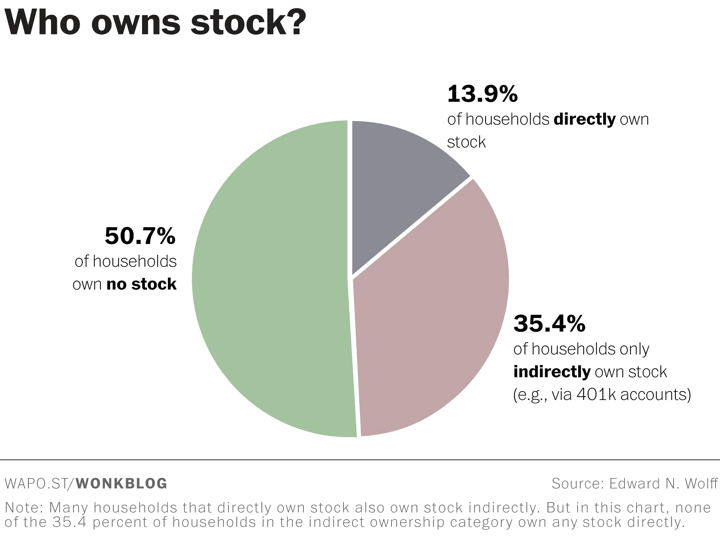Here’s another stat to add to your knowledge. For roughly half of Americans, the stock market’s record highs don’t help at all, according to a recent Washington Post article. This chart shows that half of US household have no exposure to stocks, either directly or indirectly:

Direct vs. indirect. The academic paper by Dr. Wolff of NYU was a bit confusing with their terminology. From what I read, “direct” stock ownership means owning individual shares of stock. “Indirect” stock ownership includes “mutual funds, trusts, or various pension accounts”. Here, the term “pension accounts” include defined contribution accounts like IRAs, 401(k), and 403(b) plans. However, assets in defined benefit plans, which is the more traditional definition of the term “pensions”, are not included under “pension accounts”. Social Security is also excluded. Got that?
In theory, you don’t need to own stocks to have a comfortable retirement. You could have a mix of other resources like Social Security, private company pension plan, bank deposits, bonds, whole life insurance, commercial property, residential rental property, and so on. However, I’m willing to bet there is a healthy correlation between owning one and owning multiple forms of these productive assets.
Financial freedom means owning enough productive assets to get off the treadmill of work, spend, work, spend. I know there are probably good reasons why many people have trouble finding the money to invest in stocks. I don’t have an easy fix. However, one small tip for those on the margin is to get that spark and start viewing such assets with desire. The same desire as a nicer car or kitchen remodel. I get excited when I buy another chunk of VTI or VXUS. Others get excited when they acquire another rental property. Find a way to start your snowball.
 The Best Credit Card Bonus Offers – 2025
The Best Credit Card Bonus Offers – 2025 Big List of Free Stocks from Brokerage Apps
Big List of Free Stocks from Brokerage Apps Best Interest Rates on Cash - 2025
Best Interest Rates on Cash - 2025 Free Credit Scores x 3 + Free Credit Monitoring
Free Credit Scores x 3 + Free Credit Monitoring Best No Fee 0% APR Balance Transfer Offers
Best No Fee 0% APR Balance Transfer Offers Little-Known Cellular Data Plans That Can Save Big Money
Little-Known Cellular Data Plans That Can Save Big Money How To Haggle Your Cable or Direct TV Bill
How To Haggle Your Cable or Direct TV Bill Big List of Free Consumer Data Reports (Credit, Rent, Work)
Big List of Free Consumer Data Reports (Credit, Rent, Work)
I’d venture to guess many of that 50% are fully retired living only on Social Security and/or view SS as their retirement plan.
Interesting info on SS:
https://www.ssa.gov/news/press/factsheets/basicfact-alt.pdf